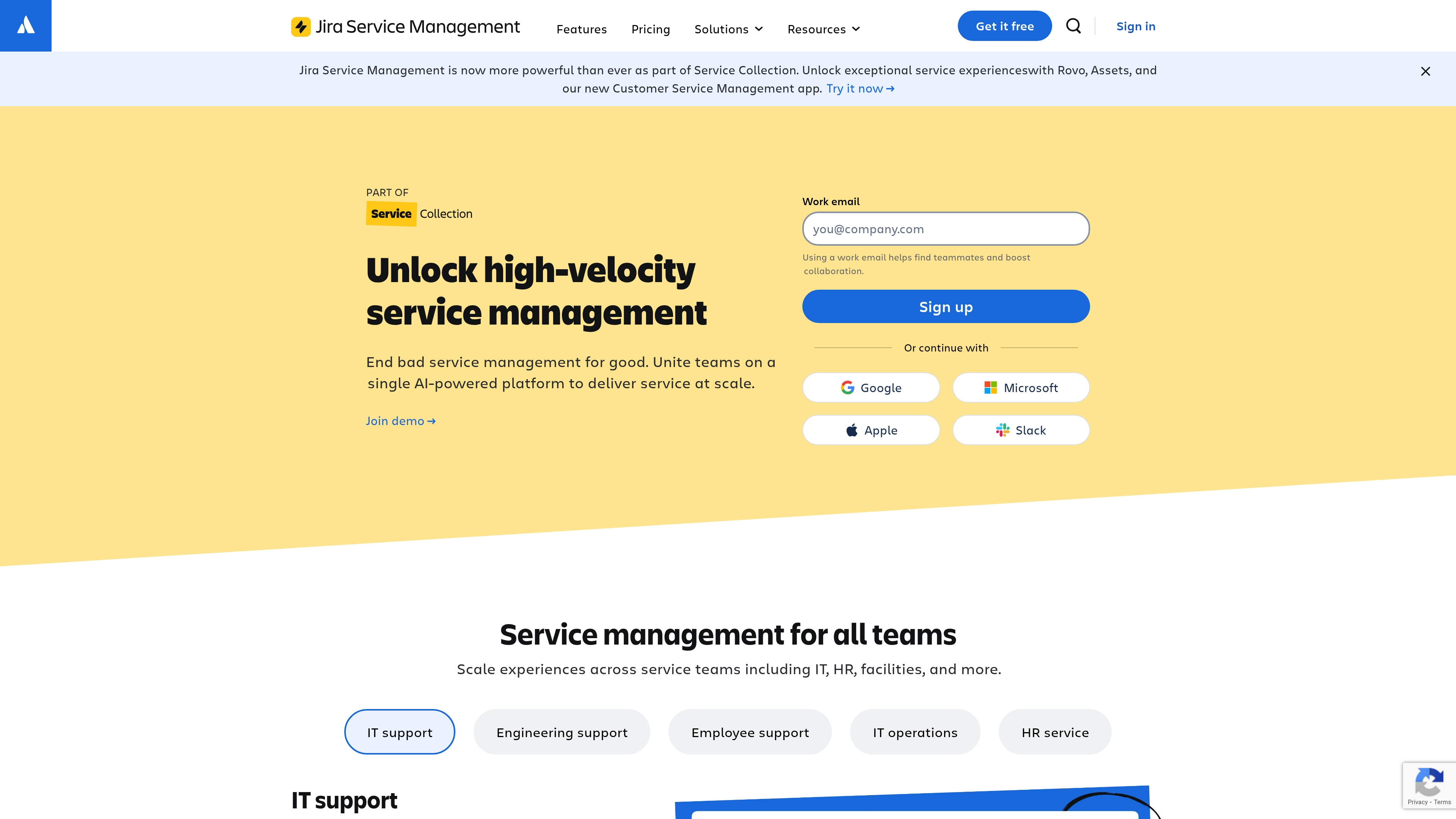For field teams, every service request depends on assigning the right technician. Manual spreadsheets and calls slow operations and cause delays. Dispatching software automates routing and scheduling so requests reach the right person instantly, with live visibility for everyone involved.
This guide explores how modern dispatching systems work, from automated routing and AI-powered scheduling to successful implementation. We will also compare the top platforms to help you find the right fit for your team.
Try monday serviceKey takeaways
- Automate dispatch so the right technician gets the right job faster.
- Share real-time status and ETAs to raise transparency and trust.
- Track SLAs, first-time fix rate, and utilization to improve performance.
- Connect dispatch with projects and reporting in monday service for end-to-end visibility.
What is dispatching software?
Dispatching software manages incoming service requests and automatically routes them to the right technician based on skills, location, and availability. Teams track every step of a request from intake to resolution in one workspace.
It centralizes assignments, schedules, communication, and updates so everyone works from the same real-time data. With fewer manual steps, dispatchers make faster decisions and field teams complete jobs sooner.
How dispatch management software supports service operations
Dispatch management software connects people, data, and workflows to move service requests from intake to completion. Automation assigns tasks, updates progress, and surfaces insights that keep operations efficient.
Automated ticket routing and assignment
Route new requests to qualified technicians using skill sets, capacity, and proximity. Automation reduces manual triage and shortens response times.
Real-time tracking and status updates
Track technician location, job progress, and ETAs in real time. Live visibility helps teams communicate updates faster and resolve risks before they delay work.
Integration with service platforms and systems
Sync with CRM, inventory, and communication tools to keep every record aligned. Field teams access customer context, asset details, and available parts as soon as a job is assigned.
Streamline field operations with automated dispatch
Automated workflows route tasks to the right technician and reduce travel time. Teams complete more jobs per day while keeping workloads balanced. Real-time updates improve communication and help customers stay informed.
Standardized intake forms and routing rules reduce manual decisions and create consistency across every team. Measure key metrics such as cycle time, first-time fix rate, and SLA performance to guide ongoing improvements.
Core dispatching features that drive efficiency
Effective dispatching systems bring structure and speed to service operations. The right platform equips teams to manage jobs, locations, and schedule changes with precision.
Key capabilities include:
- AI routing: Assign jobs automatically based on skills, workload, and urgency.
- Mobile access: Capture updates, notes, and proof of work directly from the field.
- Automation: Trigger alerts, approvals, and status changes without manual input.
- Analytics: Track SLAs, technician utilization, and completion trends in real time.
These features help teams focus on high-value work while maintaining clear visibility across every service request.
How AI improves dispatch management
AI gives service teams the intelligence needed to prioritize work and stay proactive. It analyzes requests to match the right technician, predict demand, and identify potential risks before they affect customers.
AI-powered routing and scheduling help teams allocate resources effectively and meet SLAs with greater consistency. Predictive analytics highlight upcoming workload spikes, allowing managers to plan capacity and staffing ahead of time.

Within monday service, AI operates behind the scenes to categorize tickets, manage capacity, and flag potential delays. Teams spend less time coordinating and more time delivering quality service that strengthens customer relationships.
Try monday service5 steps to implement dispatch software successfully
Rolling out dispatch software requires planning, collaboration, and clear goals. Following these five steps helps teams move from evaluation to adoption with confidence.
Step 1: Map your current service processes
Document how requests move from intake to resolution. Track handoffs between dispatchers, technicians, and supervisors to identify friction points and repetitive steps. A clear baseline makes it easier to measure improvements later.
Step 2: Define goals and KPIs
Set measurable goals that reflect team performance and customer experience. Track metrics such as first-time fix rate, technician utilization, SLA attainment, and response time. Start with realistic targets that can expand as adoption grows.
Step 3: Configure integrations and workflows
Connect dispatch software with CRM, inventory, and communication tools. Build automations that handle ticket assignments, notifications, and updates without manual work. Test integrations before launch to confirm data and routing accuracy.
Step 4: Train teams for adoption
Tailor training for each role. Dispatchers need workflow setup guidance, technicians need mobile access practice, and managers need reporting training. Identify early adopters who can support peers during rollout and share real-world tips.
Step 5: Monitor and refine performance
Review analytics regularly to track KPIs and user feedback. Adjust routing rules, workflows, and staffing as trends emerge. Encourage ongoing input from field and dispatch teams to improve both system use and customer outcomes.
Top dispatch software platforms for service teams
The best dispatch platforms bring clarity, automation, and scalability to field operations. These tools centralize requests, schedules, and communication so teams can resolve issues faster and operate with greater visibility.
1. monday service
monday service helps teams manage every service request, from intake to resolution, in one connected workspace. It combines AI automation, visual workflows, and real-time collaboration to make dispatch and service management simple and scalable.

Best for: Organizations managing field technicians or internal service teams that need one place to track, assign, and resolve requests.
Key features:
- AI-powered ticket routing that matches jobs to the most qualified team member.
- Real-time job tracking with technician updates and status visibility across teams.
- Customizable customer portals for tracking requests and communication.
- No-code workflow builder for intake forms, routing, and approval flows.
- Cross-department collaboration linking service, IT, HR, and operations.
- Centralized dashboards with SLA tracking and workload analytics.
Pricing:
monday service offers flexible plans for teams of all sizes, starting at $26 per seat/month. Every plan includes a free trial and scales with users and feature needs. Pricing is designed for accessibility and quick adoption across both small teams and enterprise organizations.
Why it stands out:
monday service connects every part of service delivery on a single platform. Teams automate repetitive tasks, gain visibility into workloads, and move from manual coordination to proactive service management.
2. ServiceNow
ServiceNow provides enterprise-scale field service management through its Now Platform. It unifies dispatch, scheduling, and service workflows across departments with AI-driven automation.

Best for: Enterprises with complex service requirements that need deep workflow control and cross-department visibility.
Key features:
- Centralized dispatcher workspace with live mapping and workload views.
- AI-based scheduling that assigns work using skills, distance, and priority.
- Mobile Agent app for offline access, job updates, and inventory tracking.
- Advanced SLA tracking and compliance tools for large-scale operations.
- Integrated analytics for performance and capacity management.
Pricing:
Pricing is customized based on organization size and modules.
Considerations:
- High implementation costs and complexity can be prohibitive for smaller organizations without dedicated IT resources
- Steep learning curve requires significant training investment, particularly for the Field Service Management module configuration and customization
3. Jira Service Management
Jira Service Management extends Atlassian’s ecosystem to service and dispatch operations. It connects development, IT, and field teams through shared workflows and automation.

Best for: Technology-led organizations that use Atlassian tools and want to integrate dispatch and service operations within existing workflows.
Key features:
- Native integration with Jira Software and Confluence for unified ticketing and documentation.
- Automation for routing, notifications, and status updates.
- Large marketplace for scheduling and field management apps.
- Real-time collaboration between developers and service agents.
- Custom dashboards and analytics for SLA and workload reporting.
Pricing:
- Free: $0/month for up to 10 users with 2 GB storage
- Standard: $7.53/user/month with 250 GB storage for up to 100,000 users
- Premium: $13.53/user/month with unlimited storage and 99.9% uptime SLA
- Enterprise: Contact sales for annual billing with 99.95% uptime SLA
Considerations:
- Lacks native dispatch management functionality, requiring third-party marketplace apps that can create integration complexity
- Steep learning curve for non-technical users, potentially challenging initial setup and configuration for field service teams
4. Zendesk
Zendesk supports customer service and field operations through its ticketing platform and integration marketplace. It helps teams convert customer requests into field jobs and track progress in real time.

Best for: Support teams that want to extend customer service workflows into field service operations using a familiar interface.
Key features:
- Ticket-to-dispatch workflow that connects support and field technicians.
- Integration ecosystem with over 1,200 apps, including Zuper and Fieldproxy.
- Real-time communication between agents, dispatchers, and technicians.
- AI tools for ticket triage and self-service.
- Built-in analytics for response times and resolution trends.
Pricing:
Plans start at $19 per agent/month (annual billing). Higher tiers add AI automation and analytics, with free trials available across all plans.
Considerations:
- Requires separate subscriptions for third-party FSM software, which can increase total cost of ownership
- Lacks native dispatch management capabilities, making businesses dependent on external integrations for field service functionality
5. Freshservice
Freshservice delivers IT service management with built-in automation and a modern interface. It offers dispatch functionality through integrated field service modules that handle scheduling and communication.

Best for: Mid-size teams looking for an intuitive ITSM platform with optional field service extensions.
Key features:
- AI-driven scheduling for assigning and prioritizing jobs.
- Live chat and mobile communication between dispatchers and technicians.
- Built-in asset and inventory tracking connected to tickets.
- Workflow automation for routing, approvals, and escalations.
- Pre-built reports for SLAs, utilization, and response times.
Pricing:
Plans start at $19 per agent/month (annual billing). Advanced features, including field service management, are available through partner integrations such as GoDeskless FSM.
Considerations:
- Advanced dispatch management relies on third-party marketplace integration rather than native functionality, which could create potential gaps in user experience
- Limited public reviews available for the field service management integration, making it difficult to assess real-world performance and customer satisfaction
Streamline service operations with monday service
monday service gives teams one place to manage every service request from intake to resolution. The platform combines automation, analytics, and collaboration to simplify dispatching, accelerate response times, and improve service quality.
AI-powered automation
Built-in AI categorizes and routes incoming tickets to the right person based on expertise and workload. Automation reduces manual sorting, shortens response time, and helps teams focus on solving complex issues instead of managing logistics.
No-code workflow customization
Use a visual builder to create custom approval flows, escalations, and location-based routing. Update workflows as operations evolve to stay agile and aligned with changing team structures.
Cross-department collaboration
Link service, IT, operations, and HR requests in one workspace. Shared dashboards keep every team informed and eliminate delays that stem from disconnected systems. Unified visibility helps organizations deliver consistent, efficient service across departments.
Build smarter, faster service operations
Dispatching software turns complex service management into a connected, transparent workflow. Teams coordinate faster, reduce manual work, and gain full visibility across every stage of service.
With monday service, automation, collaboration, and AI-powered routing come together on one platform to help organizations deliver better service with less effort.
Start simplifying dispatch management and elevate your team’s performance today.
Try monday service Get started
Get started 

